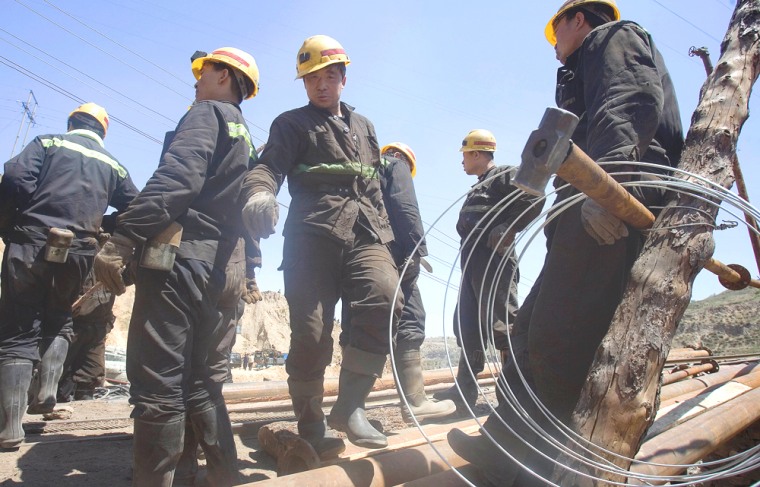Crews searching for 57 coal miners trapped for five days by an underground flood began pumping water from their mine Tuesday, as residents began to lose hope for a successful rescue.
The pumping began after a lengthy delay that state media said was caused by technical problems and lack of power to run the giant pumps brought in by rescuers.
There were no ambulances or medical personnel on hand, suggesting that rescuers didn’t expect to find any survivors from the flood Thursday, which appeared to be China’s biggest mine disaster this year.
6,000 miners die every year
The disaster in the country’s dusty northern hill country highlighted the chaotic state of its coal mines, where some 6,000 miners are killed each year in fires, explosions and floods.
After the water pumps were turned on at about 9 a.m. Tuesday, onlookers could see a growing stream pouring from hoses leading out of the mine and into a gully below.
The pumps are capable of moving 42,000 cubic feet of water per hour, the official Xinhua News Agency said. But it said that the flooded mine could take days to drain.
“We must go all out to rescue these men. But we also need to start preparing for the worst,” Feng Lixiang, mayor of the nearby city of Datong, which administers the area, was quoted as saying in local newspapers. Shen Wenhui, a wife of one missing miner, said she was “in despair” with no news of her husband.
Questions on management
The undercurrent of pessimism added to an emerging picture that the Xinjing mine was poorly managed and indifferent to safety. China’s top work safety official, Li Yizhong, on Monday accused its managers of sending miners into a coal seam beyond its approved area and other officials alleged the managers tried to cover up the accident.
Mine manager Li Fuyuan and at least eight other officials have been detained for questioning, although the mine’s owner fled, state media reported. A spokesman for the national work safety office, Huang Yi, said investigators were looking to see whether local officials have financial ties to the mine.
“There’s no such thing as accidents. They’re all caused by human factors,” said Fang Zhipeng, a 47-year-old worker at a neighboring mine and one of scores of onlookers watching the rescue workers at Xinjing, which lies in bone-dry countryside about one-hour’s drive from the mining center of Datong.
Such negligence is common in China, where coal is an addiction and the mines are among the deadliest in the world, with about 6,000 deaths a year. China relies on coal for two-thirds of the energy needed to fuel the robust economy. Mines routinely disregard safety regulations — and appeals from Beijing — to mine more coal and make more money.
Decent wages, grim living
Even by these standards, the situation at Xinjing appeared particularly dismal. Wages were as high as $600 a month — a huge sum in a country with an annual average income of about $1,000.
Yet living conditions were grim and primitive for the 1,500 miners and their family members, mostly migrants from poorer rural areas. Dormitories of wood and brick spread across the bottom of a dry creek bed below the mine, where garbage blew in the breeze. There appeared to be no sewage system or running water.
Police maintained checkpoints along roads leading to the mine and a dozen cruisers patrolled the area, possibly to guard against violence by angry miners or relatives of the missing.
State media, which often gives scant attention to mining disasters, gave prominent coverage to Xinjing’s problems, underscoring Beijing’s anger.
Family members whisked away
When the accident occurred, managers reported only five fatalities, later revising the number of missing to 44 and then 57, the reports said. Family members of the missing were driven across the nearby provincial boundary into Inner Mongolia to keep them quiet, reports said.
Managers didn’t keep track of how many miners were in the pit during shifts and dismissed warnings from miners about water leaks in the shaft at least three days before the accident, state media reported.
Miners who wouldn’t give their names said accidents were frequent and complained that managers pressured them to dig faster or be fired.
The trapped miners were reportedly mining a seam outside the mine’s approved operating range when they bored through to an abandoned shaft filled with water that streamed in under high pressure, the official Xinhua News Agency reported.
Standing outside his tiny dormitory room beside a stinking toilet, a miner from the central province of Henan said he simply ran when he heard shouts that water had entered the mine.
“I was near the entrance, and when we heard there was water, we ran,” said the man, who would only give his surname, Wang.
